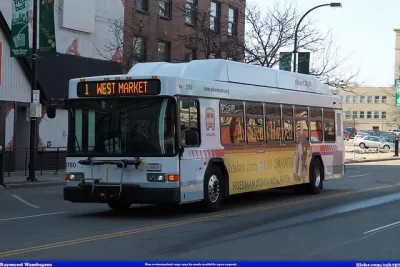A new study by Rahul Pathaka, Christopher K. Wyczalkowskib, Xi Huangb produces new evidence for the most effective method for improving conditions of poverty.

[Updated January 15, 2018] Affordable housing projects might not be the best way to improve concentrated poverty. In fact, "[n]ew research suggests that a more effective approach to changing the geography of poverty requires the expansion of effective public transportation systems," according to an article by Andrew Miller.
The study, published in the Regional Science and Urban Economics journal, finds evidence that, for transit-dependent commuters, the affordability of a neighborhood can depend on proximity to transit stops. The study analyzes tract-level U.S. census data in the Atlanta metropolitan area from 1970 to 2010. According to Miller, "the authors found that the presence of a public bus route in Atlanta’s suburban census tracts is associated with a 2.32 percent increase in the poverty rate on average, compared to census tracts without bus routes."
The study also established a causal relationship between bus routes and poverty, and expands similar findings from previous studies to suburban settings.
FULL STORY: HOW PUBLIC BUS ROUTES CAN DECONCENTRATE POVERTY AND PROMOTE EQUITY

Trump Administration Could Effectively End Housing Voucher Program
Federal officials are eyeing major cuts to the Section 8 program that helps millions of low-income households pay rent.

Planetizen Federal Action Tracker
A weekly monitor of how Trump’s orders and actions are impacting planners and planning in America.

Ken Jennings Launches Transit Web Series
The Jeopardy champ wants you to ride public transit.

Crime Continues to Drop on Philly, San Francisco Transit Systems
SEPTA and BART both saw significant declines in violent crime in the first quarter of 2025.

How South LA Green Spaces Power Community Health and Hope
Green spaces like South L.A. Wetlands Park are helping South Los Angeles residents promote healthy lifestyles, build community, and advocate for improvements that reflect local needs in historically underserved neighborhoods.

Sacramento Plans ‘Quick-Build’ Road Safety Projects
The city wants to accelerate small-scale safety improvements that use low-cost equipment to make an impact at dangerous intersections.
Urban Design for Planners 1: Software Tools
This six-course series explores essential urban design concepts using open source software and equips planners with the tools they need to participate fully in the urban design process.
Planning for Universal Design
Learn the tools for implementing Universal Design in planning regulations.
Heyer Gruel & Associates PA
Ada County Highway District
Institute for Housing and Urban Development Studies (IHS)
City of Grandview
Harvard GSD Executive Education
Toledo-Lucas County Plan Commissions
Salt Lake City
NYU Wagner Graduate School of Public Service





























